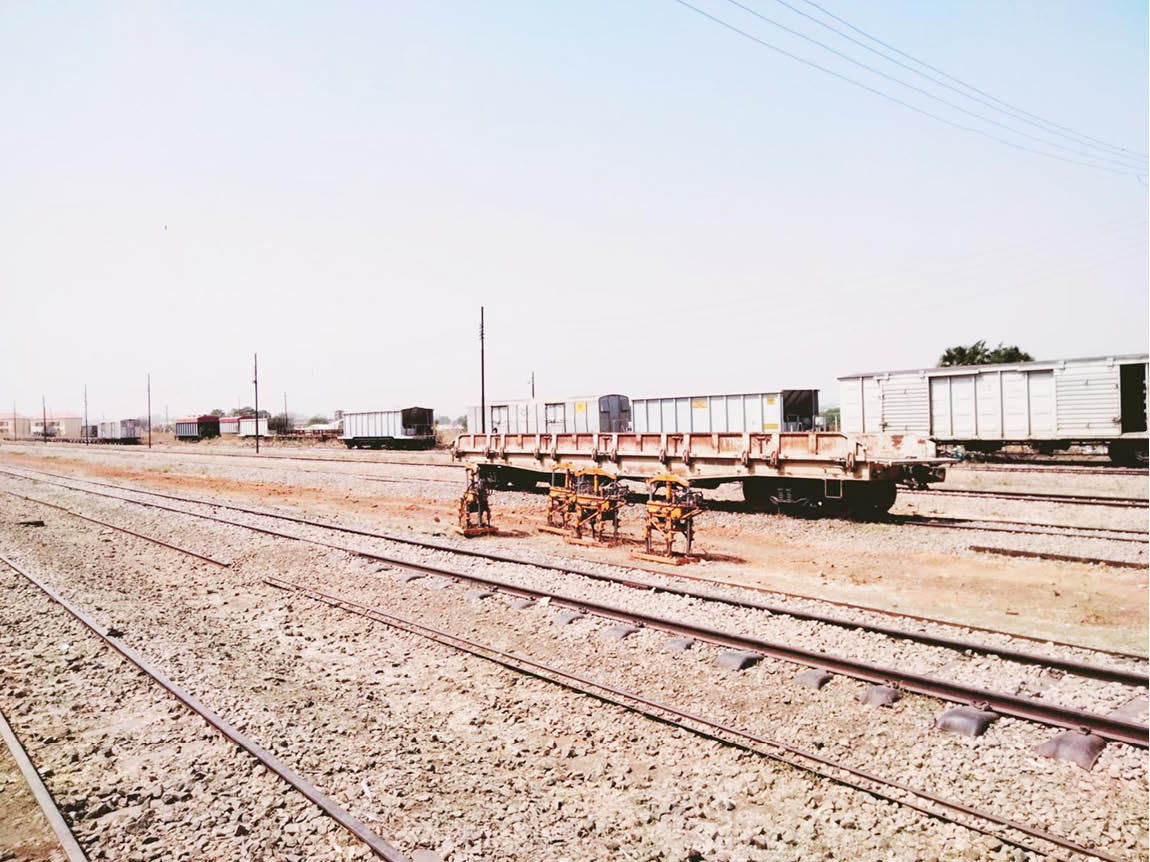In Kaduna State, the Kafanchan Railway Station gained reputation as the administrative headquarters of the defunct North-Central District of the Nigerian Railway Corporation (NRC), while Kaduna and Zaria junction stations welcomed goods and passengers from Lagos and other parts of the country. However, this is no longer the case as our correspondents report that facilities in the stations have been left to rot away even when it is evident that the Nigerian Government is working towards reviving the railway system by building new structures; one of which is the Abuja-Kaduna rail line.
In the past, working with the Nigerian Railway Corporation attracted a lot of pride and glamour, especially in Kafanchan which was the administrative headquarters of the defunct North-Central District of the Nigerian Railway Corporation. Gradually, with the system collapse, workers of the NRC now elicit sympathy among residents.
As the administrative headquarters of the then North-Central District of the Corporation, the Kafanchan Railway Station had about three sub-districts; Jos (Plateau State), Lafia (Nasarawa State) and Makurdi (Benue State). The districts covered Kaduna South in the North – from Kankomi in Kaduna to Kafanchan, from Kafanchan to terminate in Haipang, Plateau State and from Kafanchan to Igumale in Benue, after Otukpo and Makurdi stations, stretching about 571 kilometres.
- Uncertainty over identity of Kagara school attackers
- INTERVIEW: Why I quit banditry – Abductor of Kankara schoolboys

With trains running from the far North to East through Kafanchan, the North-Central District generated about 30 per cent of the railway’s revenue from passenger traffic in the late 80s. The movement of goods from the North to the East and vice-versa enhanced the socio-economic life of the benefitting areas.
For someone who knew the Kafanchan Railway Station 30 years ago, entering the station now would almost elicit tears. Today, it has been reduced to a bushy abode of reptiles. Some houses in the staff quarters have been vacated because of extensive damage, making them inhabitable. Some of the coaches and wagons at the station as sighted by our reporter have long become homes to mice, lizards and other reptiles while one among the three workshops visited by our reporter is completely damaged.
An official of the North-Central District of the Nigerian Railway Corporation, Patrick Ozemoya, said some of the facilities of the NRC were vandalized. “Some people took advantage of the condition of the railway as if it has been totally abandoned by the government. So, they started to vandalize its facilities. But in the true sense, it is not abandoned because the government of the day is trying its best to revive the railways,” he said.
Ozemoya explained that in the 80s, the movement of trains in and out of Kafanchan was daily, adding that almost three passenger trains were either coming or leaving the station daily.
“We had Lagos-Jos (3PL), Lagos-Maiduguri (11ML) and Kano-Port Harcourt and each had no fewer than 16 to 17 wagons with 96 passengers, in addition to the daily mass transit from Kaduna to Kafanchan every day, apart from cattle train from Maiduguri to Port Harcourt, Kaduna to Maiduguri and Port Harcourt to Kaduna thrice in a week.
“But now, we have only one train moving from Kano to Port Harcourt (with only seven wagons). In the late 80s we had about 15,000 staff in the North-Central District but now, we have only about two to three thousand, some have died while some retired,” he said.
He said past governments and the present have sunk billions of naira into the rehabilitation of the NRC, adding that President Goodluck Jonathan’s administration had started with the standard gauge which was completed by the present administration of President Muhammadu Buhari.
“You see, when this government came into power, they focused on Standard Gauge which they inherited from the past administration of Goodluck Ebele Jonathan and made sure that Nigerians are benefitting from it,” he said.
“Now, the Federal government has turned to the Narrow Gauge, and in November 2020, they awarded the contract of reviving it. If not because of Covid-19 outbreak, I believe the story would have been different but we hope to see it as soon as the government overcomes the issue of coronavirus in the country. You have started seeing the road construction which is among the projects of reviving the system,” he added.
Set back in Kaduna’s attempts to kickstart mass transit
With the collapse of the train system in the country some 20 years ago, fruit sellers at the popular station market in Kaduna who used to transport fruits from the southern part of the country through the rail lines say they were forced to transport their goods by road via trailers. They told our correspondent that this cost them more and ultimately affect price of goods as some of the fruits often get rotten when the trailers break down on the way.
Our correspondent who visited the Kaduna Junction office of the Nigerian Railway Corporation which was commissioned on December 15, 1990 by then Secretary to the Government of the Federation, Alhaji Aliyu Mohammed, observed that there was no locomotive at the station. The station which once served as a junction for passengers and goods travelling from Lagos and other parts of the state to Kano now looked nearly empty with moribund carriages, broken down tankers and visibly worn off tracks.

Our correspondent further observed from a board of train schedules written with chalk that there were stations in Lagos, Port Harcourt, Abeokuta, Aba, Ibadan, Umuahia, Oshogbo, Enugu, Offa, Ovim and Ilorin. Others include Afikpo road, Mokwa, Otukpo, Jebba, Makurdi, Zungeru, Lafia, Minna, Kafanchan, Zaria, Kano, Agege, Ede and Inisa. The fares varied between N250 and N4, 800 depending on the distance a passenger was to travel from as the passengers were categorized into sleepers, seaters and standard.
Apart from the interstate train service, several efforts had equally been made to revive the Kaduna State Railway Mass Transport Service which it was gathered used to run three flanks. The flanks comprise of the Rigachikun – Sabo layer which traverses the southern end of Kaduna city (Sabo) and cuts through the city centre northwards to Rigachikun; the Zaria flank which runs between Kaduna and Zaria North of the state; and the Kafanchan flank which connects Kaduna southwards to Kafanchan. Each flank had a train dedicated to it, meaning that the rail transit service had three trains in its fleet.
A former staff of the NRC who used to operate one of the locomotives said the train services gradually began to dwindle; beginning with the Zaria and Kafanchan trains as they became grounded, leaving only the Rigachikun-Sabo train. He explained that due to failed tracks and old locomotives, the Nigeria Railway Corporation (NRC) was forced to suspend the train movements.
“Many portions of the tracks are not in the best of conditions and we kept having engine failure because the locomotives were old and needed to be replaced. The track damage and repair challenges account for the postponement of the train trips to Zaria and Kafanchan under the Kaduna State initiative and the eventual suspension of the service,” he said.
Daily Trust Saturday recalls that during the administration of a former governor of Kaduna State, Architect Namadi Sambo, the train service resumed after being in limbo for more than two decades conveying passengers from Kafanchan to Zaria and back. Governor Sambo had flagged-off the first phase, the Rigachikun-Sabo corridor, on May 27, 2008 in Rigachikun where he said the rail service was intended to address the biting problem of goods transportation and services within Kaduna metropolis as well as complement the other transportation initiatives.

He had then stated that the innovation would be extended to cover the entire state from Sanga to Ikara and from Makarfi to Kafanchan to address transportation problems and open channels of improving free movement of people and products from farms to the marketplace.
Ibrahim Musa, who was a regular passenger on the train, recalls with nostalgia that the train was a big help to him at the central market, adding that, “It used to pass right through the market, allowing shop owners obtain their supply easily.”
Our correspondent further gathered that in February 2008, there were moves by the state government on a partnership arrangement with the NRC to introduce a special rail mass transit programme where the Kaduna State government fuels the locomotives, services them, and provides support workers who include ticket officers and a lean administrative staff to manage the programme. The NRC was expected to offer the coaches and locomotives, the drivers and technical personnel but the partnership is yet to take-off.
Attempts to get a comment from the NRC at the time of the visit proved abortive as officials said only the headquarters in Lagos can speak on the status of the railway station.

Zaria Railway Station, now a ghost town
The once busy Zaria Railway Station is now a ghost town of some sorts as the station has been deserted by passengers and most of the officials. With no activity presently at the station, our correspondent observed that it has become a convergence point for destitutes and the homeless who now find comfort in its warmth. Other residents around the station operate small scale businesses outside the station as few workers were seen within the station.
Our correspondent observed that most of the train coaches are old, decayed, out-of-date and left to rot away. The offices at the station were empty at the time our correspondent visited with shattered windows and no staff available. Faded wall paints, abandoned old coaches and locomotives at the station readily welcomes any visitor.
Daily Trust correspondent who visited the station gathered that for several months, no train had visited or taken off from the station. A staff of the station who didn’t want to be mentioned lamented the state of the Zaria train station but said a few weeks ago, an old train arrived the station with technical problems and was repaired before it left.
“As you can see the building is looking old, most of the trains are not functioning. You can see how bad the place is with no activities. Most times, we don’t even have work to do here in fact only prayers can revive this station,” he said.
Another resident of Zaria, Adamu Kugu, said it has been a long time since he saw a train pass through the junction especially since the rail track traverses through their community.




